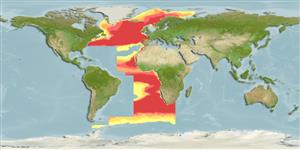Teleostei (teleosts) >
Beryciformes (Sawbellies) >
Melamphaidae (Bigscale fishes or ridgeheads)
Etymology: Poromitra: Greek, poros = porous + Greek, mitra = stripe, belt (Ref. 45335).
More on author: Lütken.
Environment: milieu / climate zone / depth range / distribution range
Ecology
Marine; bathypelagic; depth range 150 - 1000 m (Ref. 36655). Deep-water
Atlantic Ocean.
Length at first maturity / Size / Weight / Age
Maturity: Lm 5.3, range 5 - 6.2 cm
Max length : 6.4 cm SL male/unsexed; (Ref. 5951)
Dorsal spines (total): 2 - 3; Dorsal soft rays (total): 10 - 12; Anal spines: 1; Anal soft rays: 9 - 10; Vertebrae: 27 - 30. Branchiostegal rays: 8 (Ref. 36655). Large eye, measures more than 20% of head length. Body slender and angular. Scales on body and operculum mostly missing. Pelvic fin long, extends almost to anal fin origin. Gal bladder well developed (Ref. 37108).
Body shape (shape guide): fusiform / normal.
Mesopelagic species, adults trawled at depths below 400 m, juveniles below 150 meters. There is significant morphological variation between Indo-Pacific and other populations. Oviparous, with planktonic eggs and larvae (Ref. 36655).
Life cycle and mating behavior
Maturity | Reproduction | Spawning | Eggs | Fecundity | Larvae
Ebeling, A.W., 1986. Melamphaidae. p. 427-432. In M.M. Smith and P.C. Heemstra (eds.) Smiths' sea fishes. Springer-Verlag, Berlin. (Ref. 4241)
IUCN Red List Status (Ref. 130435: Version 2024-2)
Threat to humans
Harmless
Human uses
Fisheries: of no interest
Tools
Special reports
Download XML
Internet sources
Estimates based on models
Preferred temperature (Ref.
123201): 2.3 - 11.5, mean 7 °C (based on 293 cells).
Phylogenetic diversity index (Ref.
82804): PD
50 = 0.5000 [Uniqueness, from 0.5 = low to 2.0 = high].
Bayesian length-weight: a=0.01072 (0.00442 - 0.02595), b=3.10 (2.89 - 3.31), in cm total length, based on LWR estimates for this (Sub)family-body shape (Ref.
93245).
Trophic level (Ref.
69278): 3.3 ±0.3 se; based on size and trophs of closest relatives
Resilience (Ref.
120179): Medium, minimum population doubling time 1.4 - 4.4 years (Preliminary K or Fecundity.).
Fishing Vulnerability (Ref.
59153): Low vulnerability (10 of 100).
🛈
